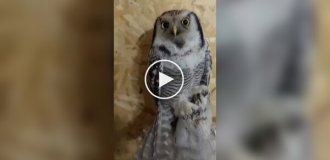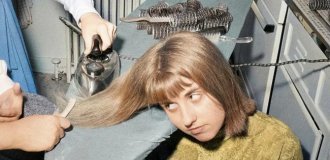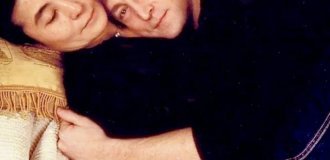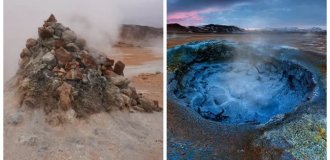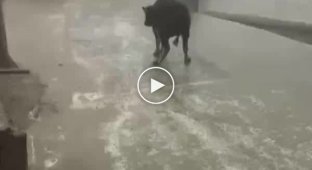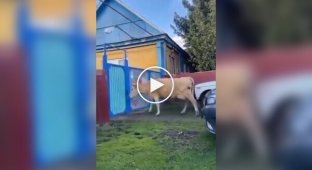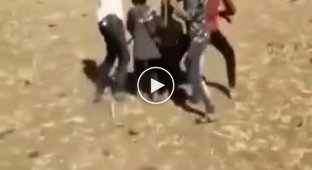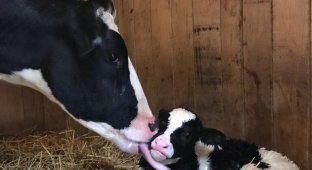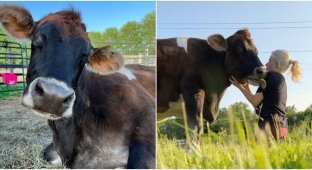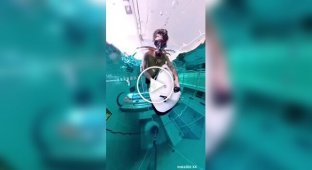A detailed analysis of all types of real bulls (22 photos)
A real bull - it's immediately clear who we're talking аbout: a huge horned monster weighing almost a ton! But the genus of real bulls is not limited to domestic cows. According to the most common classification, it consists of 7 species! 
1. A domestic cow is a man's true friend
They say that a dog is a man's best friend. But judging by the number of cattle, a cow is our real comrade! 8,000 years have passed since people domesticated cows. There are currently over 1.5 billion ungulates living on the planet. After humans and rats, this is the most numerous mammal on the planet! For comparison, the number of dogs does not even exceed a billion! 
Just imagine what would happen if all the herds united against humans!
And all because a cow can both feed and water. Man has bred over 1000 breeds of cattle, from the Holstein, which produces up to 45 liters of milk per day, to the Belgian Blue, weighing 1.5 tons! And these are only breeding animals, not counting the "mongrels" that are found in every first village. 
These are Holstein cows. They are the proud owners of the largest udders among other cows. 
And this is a Belgian Blue. This breed of cows gains a monstrous amount of muscle mass!
In addition, the domestic cow species includes the Indian zebu and African sanga cattle - very specific animals adapted to survive in a hot climate with minimal feed requirements. 
This is a zebu. It is believed that they originated from the Asian version of the aurochs, after which they went their own evolutionary path. 
And this is African cattle. They don't need such large horns for beauty - they use them to remove excess heat.
2. Yak - an indestructible mountain climber in a skirt
If your friend didn't pass the mountain test, then don't hesitate to take a yak with you on your next hike! These cows are in the mountains like fish in water. They are adapted to living at an altitude of up to 4,000 meters above sea level. Instead of newfangled equipment, they have a thick three-layer fur coat. On top is a long guard hair that protects from the vagaries of the weather, like a raincoat. In the middle is a layer of wool that protects the body from direct contact with the environment. Below is the softest and thinnest down layer. It protects ungulates from extreme temperatures, warming them even at -50! 
It's not quite clear from his eyes: is he running to show off his new fur coat or to make a new leather jacket out of the photographer?
And instead of an oxygen tank, yaks use fetal hemoglobin. This type of red blood cells is called "baby" - in humans, it is actively produced only during the embryonic period. It differs from standard hemoglobin in its greater affinity with oxygen: it more easily captures it in the lungs and more easily parts with it in the body tissues. So, yaks retain this type of blood throughout their lives. 
— It's so beautiful here, it's breathtaking! — Listen, brother, it's hypoxia, you should put on a mask!
Domestic yaks have become loyal companions for mountain peoples. They are food, clothing, transportation, and entertainment for tourists. Because nowhere else, except for the highlands of Tibet, India and China, can you ride horned ones. 
Wild and domestic yaks are two different species. It turned out to be impossible to tame the wild yak. But the domesticated ones completely died out in their natural habitat and survived only as pets.
3. Bison - risen from the Red Book
Previously, these mighty animals lived all over Europe. And now, from their endless range, there are tiny pieces of protected lands in Belarus and Poland. But even this is worth rejoicing! 
Bisons and bisons are often confused. So, our fluffy cow is taller and not so fluffy.
By the beginning of the 20th century, wild bison ceased to exist in the wild. This is not an exaggeration: they completely disappeared in their natural habitat. The species was restored only thanks to... zoos! There, 12 individuals survived. They became the ancestors of all currently living bison in the world! Six European countries, having joined forces, pulled the species back from the brink of extinction. Today, the bison population numbers about 8,000 heads. 
They survived, but they lost their former greatness. Although modern bison are considered the largest animals in Europe, the weight of adult bulls now reaches only 920 kilograms. While their ancestors grew to a record 1200. 
Love is blind, you can fall in love with a heifer from a neighboring village!
4. Bison - a monument to human cruelty
This is the largest animal on the continent. An American legend with a sad history. In the 19th century, giant herds of bison were reduced by a million (!) times, and about 500 heads remained in the wild. 
One of the most famous photographs that immortalized human cruelty. It's scary to imagine how many animals died.
Some of the bison were killed for their skins and meat, but many more were killed for fun and to spite the native population of America - so that they would have nothing to eat. The slaughtered ungulates were often left to rot. Today, the number of wild bison has increased to 30,000, but their range is only 1.2% of their historical range. 
You evicted me from my native land? Well, then I will live with you!
Wild bison grow to about 1,270 kilograms, but the "domestic" version can eat over 1,700. Unlike cows, these horned ones are not completely domesticated. To keep them, you need huge fences and well-trained personnel. In national parks, these horned ones are responsible for the majority of visitor deaths. 
Bison, why are you going on the wrong side of the road? Changing to your lane!
5. Gaur - angry giants
These horned ones proudly bear the title of the largest representative of the bovid family and are among the top 10 largest animals on the planet. Gaurs grow up to 2.2 meters at the withers and gain a record 2000 kilograms of weight. Outwardly, it looks like a mega-muscular bull-jock. And this is without any steroids! 
I wonder what kind of license you need to have to drive such a car?
But you wouldn't wish your worst enemy to meet them in the forests of Southeast Asia. Gaurs don't tolerate strangers invading their personal space. In a fit of anger, they even attack livestock, trampling them to death. The locals have to put up with the tyranny of the horned ones: the animals are listed in the Red Book, and shooting at them is strictly prohibited. 
That same muscleman who works out 20% of the time and takes pictures in front of the mirror 80% of the time.
The people of India are luckier - the gayal lives on their territory. A closely related species to the gaur, which is not averse to establishing contact with humans. These animals are kept as pets. Their dimensions are not as impressive, but their disposition is much calmer. Ungulates produce fatty milk and meat, and sometimes they even risk harnessing them to a cart or a plow. 
The enormous strength of the gaur allows them to butt even with Indian rhinoceroses on equal terms!
6. Banteng, or tembadaou - scary on the outside, kind on the inside
They look like Spanish fighting bulls: up to 190 centimeters at the withers and weighing 1000 kilograms. But these are horned ones with a delicate mental organization - they are timid and shy. They rarely attack first and always try to run back into the forest. They spend most of their time in the depths of the jungles of Southeast Asia. Bantengs are perfectly adapted to extreme conditions: in times of famine and drought, they eat algae and drink sea water! 
In the background are young individuals of banteng. They can be distinguished by their red fur.
The domesticated version of banteng is bred in Indonesia mainly for food and a little for use as draft animals. But they are not so hard workers: they work worse than other species of ungulates, and from poor treatment they can even "fall into depression". 
Excuse me, can you tell me how to get to the gym?
7. Kouprey, or forest bull - we may never see it again
The last reliable sighting of the species was recorded back in 1969, after which no one has ever seen a Kouprey. In fact, they were never numerous, in their best years there were barely more than 2,000 individuals. 
A photo of a young bull that arrived at the Vincennes Zoo on April 7, 1937.
They looked like a gaur and a banteng at the same time, growing up to 190 centimeters at the withers and gaining almost 900 kilograms in weight. The ungulates were previously considered a hybrid of these two species, and it is said that at one time koupreys and banteng even grazed together. But at the same time, the horned ones did not interbreed with each other: genetic analysis confirms that gaurs, banteng and koupreys are undoubtedly related, but still separate species. 
This is one of the few photographs that shows a kouprey. All of them were taken in a zoo - there are no pictures of animals in the wild at all.
Great! Now our beloved reader knows exactly what a real bull is. Which representative of the powerful cows did you like the most?
